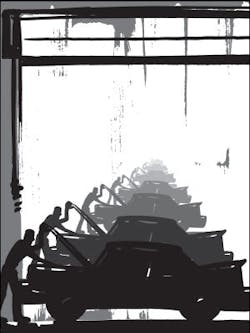Repair Shops Grow as Service Industry Shrinks
It’s not a secret that the classic gas station service shops of decades past are slowly disappearing, says consultant Bill Haas.
An industry lifer, Haas can remember a day when there was one on seemingly every corner.
“Today, it’s just a business model that doesn’t really work—or at least is very, very difficult to make work,” says Haas, who coaches independent shops through both Educational Seminars Institute and his own company, Haas Performance Consulting. “It’s very few and
far between.”
And this isn’t just anecdotal. It’s a trend of a changing industry.
In a February edition of its The Lang Aftermarket iReport, Lang Marketing pointed to a distinct shift in the automotive aftermarket to fewer but larger repair facilities—a move that has helped the light vehicle repair segment stabilize and, eventually, begin to grow through a six-year economic period that has seen many other automotive aftermarket segments crash.
The numbers: There were roughly 6,000 fewer “service stations and garages” (the report’s label that encompasses light-vehicle mechanical repair and maintenance businesses) in mid-2014 compared to the beginning of the recession in 2008; that’s a total of 124,000 businesses fitting that category. Yet, over that same time period, shops gained an estimated 13,000 service bays nationwide.
Fewer shops. More bays.
What does it mean for the average shop owner?
“What it shows is that the shops that are succeeding are the ones that are growing,” Haas says.
And those that aren’t? Well, they could be left behind.
breaking down the trend
This trend, as highlighted by Lang Marketing, is distinctly unique to the last half-dozen years. For the 20 years prior to 2008, service centers declined by more than 31,000 outlets, and the total number of bays dropped accordingly; there were 61,000 fewer service bays in 2008 than in the late 1980s, according to the report.
Lang Marketing gave two distinct reasons for this shift.
The first is the thousands of dealerships across the country that have lost their franchising agreements, forcing them to make a shift from new to used vehicle sales, while adding on a service department as an additional revenue stream.
Also, Lang Marketing points to “increasing demands placed on repair outlets” due to changes in vehicle technology, increased competition, and the ability to properly invest in training and tooling for modern vehicles.
The conclusion, according to the report, is that larger shops can better afford the upgrades necessary to continue to repair today’s highly sophisticated vehicles—and withstand the market pressures of consolidators and chains.
And even more numbers demonstrate that success: The average service center installed roughly $191,000 of products on vehicles in 2014, an increase of about $40,000 per shop compared to 2008.
Is Bigger Better?
Surviving as a small, one- or two-bay repair facility is nearly impossible in today’s market, says Bob Wills, the mechanical director for the Automotive Service Association (ASA).
“In time, two- and three-bay shops will be gone because of the technology changes. They just won’t be able to keep up,” he says reluctantly. “You simply have an advantage with the more resources that you have.”
Wills’ own shop, Wills Auto Service in Battle Creek, Mich., has six bays and three technicians. Even then, he says his team feels the strain of keeping up.
The ASA’s annual “How’s Your Business?” survey of independent shops seems to back up the idea that bigger is better.
The survey is issued only to ASA member shops, 84 percent of which say they have four or more operational bays, according to the survey. Seventy-eight percent of the shops work on 100 or more vehicles per month. Not surprisingly, 75 percent of the survey respondents claim annual gross sales for 2014 of more than $500,000; 32 percent were above $1 million.
Those types of numbers aren’t feasible for a small, one- or two-bay shop, Haas says. And those number might be necessary to make the investments needed to not just grow but simply survive.
“Technology will continue to evolve, and you have to have the manpower and the skillsets and knowledge to refine your business and be able to remain profitable,” he says. “That’s the question: Can you make these changes and investments and still remain profitable?”
Haas says one solution many shops have looked to is specialization—focusing on a key differentiator for a business that can make it stand out and keep market share away from competitors.
If you’re going to stay small, Haas says, you simply have to be better.
“Know your numbers, know your numbers, know your numbers,” he says to drive home the point. “You don’t have a margin for error. All your decisions need to be data driven.”
About the Author

Bryce Evans
Bryce Evans is the vice president of content at 10 Missions Media, overseeing an award-winning team that produces FenderBender, Ratchet+Wrench and NOLN.
